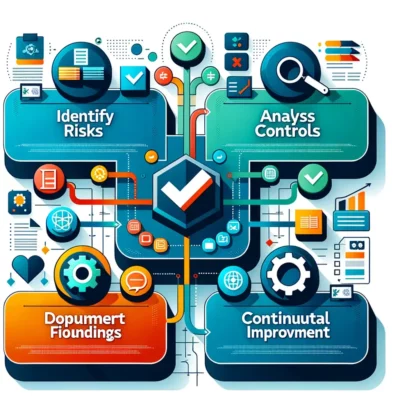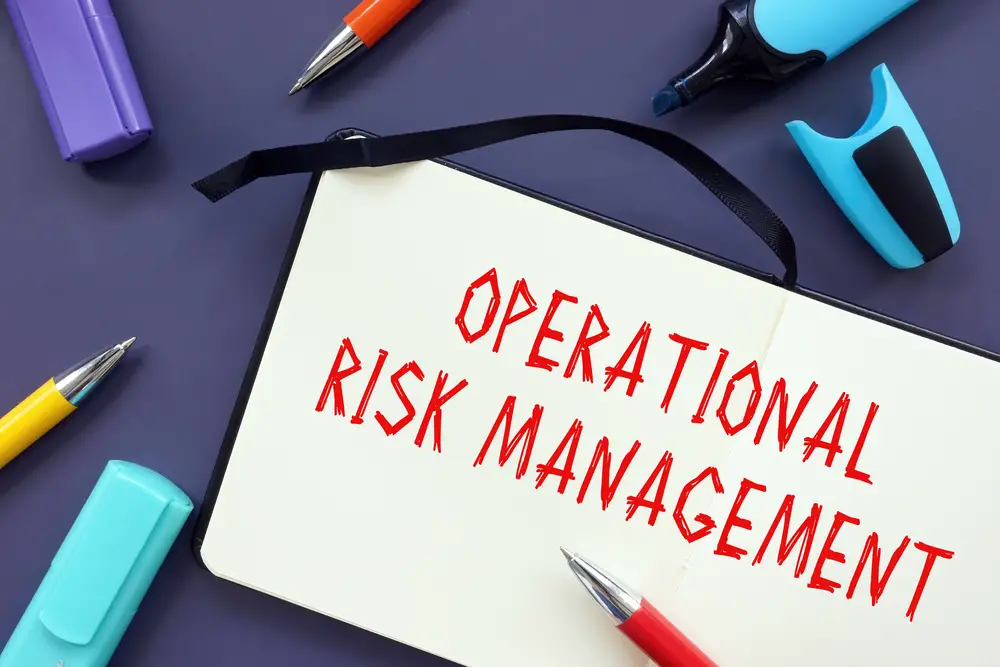Operational risk management is the process of identifying, assessing, and responding to risks that could adversely affect the operation of an organization.
The goal of operational risk management is to protect the organization by effectively identifying and mitigating risks.
It helps organizations to protect their people, property, and reputation by identifying potential risks and taking steps to mitigate them. Operational risk management is a key part of any organization’s overall risk management strategy.
Most organizations have some form of risk management in place, but effective operational risk management is often overlooked. Many operational risk management functions mistakenly believe that they are already managing operational risks effectively when, in fact, they are not.
This can lead to serious consequences when an unexpected event occurs and failed internal processes. A well-developed operational risk management program can help an organization avoid or minimize these consequences.
Operational risk management consists of four main steps: identification, assessment, response, and monitoring. These steps are designed to help organizations identify potential risks and take steps to mitigate them.
The first step in operational risk management is risk identification itself. This step involves identifying the types of risks that could adversely affect the operation of an organization like financial risk. Common types of risks include natural disasters, accidents, system failures, and security breaches.
Once the types of risks have been identified, the next step is to assess the likelihood of each type of risk** occurring**. The assessment step also involves assessing the potential impact of each type of risk. This self assessment step helps organizations prioritize which types of risks need to be addressed first.
The third step in operational risk management is the response. This step involves developing plans and procedures for responding to risks that have been identified as being likely to occur. The response plans should be designed to minimize the impact of the event on the an organization’s operations and its people.
The fourth and final step in the operational risk management process is monitoring. This step involves monitoring for events that could trigger the need for a response plan. Monitoring also helps to identify new or emerging risks so that they can be added to the list of risks being managed by the organization.
Operational risk for banking institutions is no longer an established concept. The risk category of a financial institution is now viewed as the total inputs main risk profile. The emergence of the bank was most likely made possible by a BBS Committee in Basel.

What is an Operational Risk Manager?
The British Bankers Association defines operational risks for banks as “the loss caused by a failure in an external event”. Despite the economic turmoil in 2008 financial institutions developed sophisticated systems to reduce risk. Unfortunately, they were not addressing operational risks as efficiently.
During the europe – ten years since establishing the Internal Control and Risk Assessment Method, the methods of evaluation have evolved.
Standardization was triggered in response to a growing demand by public regulators and institutional investors in the US aimed at improving transparency and assurance of risks.
Several financial frauds at Worldcom, Enron, and a global financial group led to increased pressure to develop effective operational risk management policies & procedures for organizations and their customers.
Global Risk Oversight Report depicts reports that over the past four years, the volume and complexity of risk posed to businesses have significantly increased with 32% of companies experiencing an operating unexpected event over the same period. Business risks and categories of operational risk like credit risk, compliance risk, and strategic risks
The more complex the risk incurred, the higher the frequency, and the greater the cost and the doc for its implementation. In recent years the financial sector lost almost $100 million due to failure to adequately manage operational risks.
Oftentimes, when we think about risk management solutions, the first things that come to mind are operational risks – business disruptions, natural disasters, and other events that can hurt an organization’s ability to conduct operations.
While it’s certainly important to understand and mitigate these risks, other types of risks should also be taken into consideration in business decisions. Example include market risk and reputational risk.
In this blog post, we’ll discuss what an operational risk management program is and outline some of a role – the key components of an effective ORM program. We’ll also look at some real-world examples of organizations that have experienced operational risks and how they managed those incidents. Stay tuned!
Definition of operational risk managemen
Operational Risk describes losses from failing internal control failures, processes or external events at an enterprise, bank or other financial institution.
Operational Risk includes legal risks in responding to disruptions to everyday business operations; it also involves reputation risk and strategic risk.
Operational risks are embedded in everything that happens in every organisation. Optimal Risk Management focuses on risks with the biggest impact on the company. Optimal Risk Management requires accountable staff to handle operational risks.
Mitigation of operation risks is important component of business continuity of operation. Often the company will use specialists who specialize in Risk Assessment and may even seek outside help. Several approaches can be used to build a robust risk management framework that covers business risk.
Challenge of Operational Risk Management
Risk management is a critical component of the organisation’s ability to meet customer needs. Although operational risk management is part of enterprise risk management, similar challenges such as conflicting priorities and low perceived value affect the proper functioning of both programmes.
Managing is looking at risks from two viewpoints. The traditional enterprise risk approach focuses on achieving the optimal balance between risk versus reward. Sometimes the company accepts more risk to grow it quicker, and the emphasis moves to manage risks with slower development.
Operational risk management is a riskless approach focused on protecting the organization’s strategic objectives. Find out how operational risks are managed and how to implement them in the ORM process.
What is Operational Risk Management’s primary objective?
As its names indicate, the goal of operational risk management is to minimize risk in relation to everyday operations in organizations. Operational risk management is a practice focused primarily on operation but excludes other risk domains, such as strategic or fiscal risk.
While other risk disciplines, such as ERM, emphasize optimizing risk appetites to match risk-taking and possible reward, ORM processes emphasize controls and eliminating risks. Ideally, ORMS begins with risk deciding upon risk mitigation scenarios. Operational Risk Management is aimed at the protection of organizations through the removal or minimization of risks.
Regulations
Risks from non-compliance are present in almost all organisations in various forms. Almost all industries require operationalized controls and regulations, but all regulation is largely about internal controls. As of the beginning of 2009, there was a germany rise in regulations and penalties, and the number was progressively higher.
Understanding the source of risk will aid in determining the management of operational risks. Enterprise risk management is a risk management method that aims to mitigate and manage risk that a results from a variety of sources but also reduce risk. Several organizations are using Integrated (IRM) to improve their effectiveness.

4 Best Practices for RCSA Regulations Compliance
Technology
Technology risks include hardware and technology risks and computer security from a security standpoint. Technology risks are likewise confined to all departments as well as people categories mentioned earlier. Hardware restrictions can be detrimental, especially for remote jobs. Software may also reduce productivity if apps improve effectiveness but employees lack training skills.
Software has a positive effect on client interaction with your organisation. External threats are created by hackers – applications that try to steal information and hack networks. These can cause customers’ personal details to leak or raise privacy issues.
People
The people categories are employees, customers, vendors, and others. Employee risk involves human error ,deliberate wrongdoing and data entry / application errors. Risk includes breaches of the Policy, inadequate instruction , poor education, bad choice and fraud.
Aside from the organisation, there may be operational risks including people. Employees, customers and vendors pose risks through social media. Monitoring and controlling people aspects of operational risk is a broad area of concern.
Operational Risk Management in Banking
Operational risk management is essential to financial institutions. The ongoing risk management process that includes risk assessment, decision-making and adopting internal controls for preventing risk. including implementing the above business practices and controls in its systems, processes and culture so that it operates effectively, executes its business strategy and maintains a strong competitive advantage. It is important to refocus a business on increasing its resilience and remedying critical vulnerabilities using data-based data analysis.
How does operational risk management work?
The goal of operational risk management is to handle operational risks effectively. The organisation should be careful in handling operations risks in the face of a variety of challenges and goals. Since operational risks can be easily identified by identifying and controlling risks, it aims toward decreasing and controlling risk levels. Operational Risk management helps to reduce risks by identifying, assessing, monitoring and minimizing risks, monitoring and reporting on the operational risk management orm, and reporting on the operation risk management activities and the risk.
Monitoring and reporting
The risk of an event is continuously assessed by a risk assessment for the possibility of change in time. Risk changes can be reported to the senior management, managers or boards to facilitate decision-making processes.
Measurement and mitigation
In risk assessments, risks are assessed against a common scale which allows risk priority and ranking relative. Measurements take into account costs associated with controlling potential exposure flis.
Operational Risk Management Strategies for Banks and Financial institutions
Operational Risk Management is an important tool for organizations in finance. Risk managers should therefore develop and maintain a comprehensive operational risk management plan using the strategies outlined a section a below.
Develop key risk indicators
Key indicators that inform leadership on upcoming risks. Testing and managing operational risk knowledge & process management systems, controls and Risk metrics may help identify factors influencing risks such as spikes in transactions and regions operating under stressful conditions.
Organisational leaders are then empowered to make risk decisions identify opportunities, categorise and reduce risk through banking supervision.
Combine cyber security with operational risk modeling
Operational risk is strongly correlated in the context of cybersecurity risk and data breach risks. As such, by combining insights – the best cybersecurity practices and operational risk models, enterprises can create measurable improvements that will reduce operational risk and adhere to basel committee on banking recommendations.
Training for employees
Employee awareness of risk is key component of an operating risk management program. This can be important in business units that want to change their customers’ interface or introduce new products or services.
Evaluate the Risk Profile
For better operational risk management every financial institution/provider must assess its Risk Profile. Moreover, the organisation should examine its business processes and map its resiliency with associated risks.
Top operational risks in banking and financial services
Recent changes to banking industry structures have created unanticipated operational risk exposure for banks. This includes:-
Internal and external fraud
A new study found that nearly 40 per cent of digital banks experienced increased fraud in 2020. Operational risk loss is caused by internal swindling of assets resulting from bribery and theft.
Fraud committed by external partners can include checks fraud and theft. The risk resulting mainly arising from the massive growth of transaction volumes is the use of sophisticated tools to detect fraudulent transactions as well as the gaps caused by increasing digitization and automation.
Business disruptions and system failures
Failure of hardware or software systems, power failures or interruption of telecommunication services could affect the operation or financial loss. A number of additional risks are possible to affect the financial sector as well as increase the reputation of the business or create legal issues. Losses of operational risk may destroy financial services firms. The risks are disproportionate to the firm’s reputation and compliance posture.
Third-party risks
For banks to be successful, they must identify, analyze, and mitigate third-party risks during their relationship, as well as monitor their effectiveness during the lifecycle.
However bank customers must consider the fourth party to whom a company’s transactions are conducted, and these risks must be identified, evaluated, and managed.

What is Third-Party Risk Management Lifecycle?
Cybersecurity Risks
Even when banks are increasing their cybersecurity efforts, cyber risks like ransomware and malware are increasing. This especially occurs after pandemic times when threat actors use security weaknesses to carry out serious cyber attacks.
Conclusion
Operational risk management is an important part of running a safe and successful business. By taking the time to assess your risks and put in place measures to mitigate them, you can protect your company from potential financial losses and keep your employees and customers safe. Have you implemented an operational risk management strategy into your business? If not, now is the time to start!

Chris Ekai is a Risk Management expert with over 10 years of experience in the field. He has a Master’s(MSc) degree in Risk Management from University of Portsmouth and is a CPA and Finance professional. He currently works as a Content Manager at Risk Publishing, writing about Enterprise Risk Management, Business Continuity Management and Project Management.

